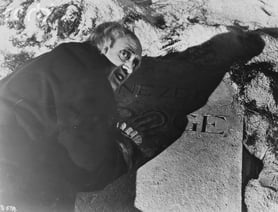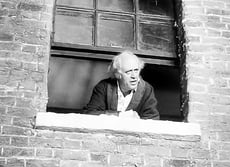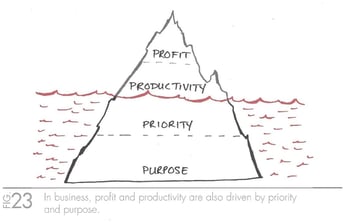 My favorite Christmas Movie, and possibly my favorite movie of all time, stars Alistair Sims in Charles Dickens, “Christmas Carol.” Every Christmas Eve I make time to watch it. It doesn’t seem like Christmas without it.
My favorite Christmas Movie, and possibly my favorite movie of all time, stars Alistair Sims in Charles Dickens, “Christmas Carol.” Every Christmas Eve I make time to watch it. It doesn’t seem like Christmas without it.
It is striking that in The ONE Thing: The Surprisingly Simple Truth Behind Extraordinary Results by Gary Keller, Jay Papasan Keller points to this story as a basis for why purpose is so critical to achieving Your ONE THING.
Before Keller delves into Dickens “Christmas Carol,” he offers this quote, “Life isn’t about finding yourself. Life is about creating yourself.” —George Bernard Shaw
The story of the transformation of Ebenezer Scrooge is most definitely about creating yourself, or in Ebenezer’s case, recreating yourself. I’ve found this even more profound due to my recovery from AML, and the power Joe Dispensa’s book, “Breaking the Habit of Being Yourself”, had upon my spontaneous remission.
Here’s how Keller briefly describes the story and transformation of Scrooge: The redemptive tale of Scrooge’s transformation from stingy, callous, and unloved to considerate, caring, and beloved is one of the best examples of how our destinies are determined by our decisions, our lives shaped by our choices.
Dickens describes him as a man whose old features are frozen by the cold within him. Tight-fisted, with head down and hand to the grindstone, Scrooge pays as little as possible and keeps as much as he can. He is secretive and solitary. No one ever stops him in the streets to say hello. No one cares, for he cares for no one. He is a bitter, mean, covetous old sinner—cold to the sight, cold to the touch, and cold of heart, with no thaw in sight. His life is a lonely existence, and the world is worse off for it.
A transformation occurs when Scrooge is visited by his former partner, Jacob Marley, who is now a chained and tormented ghost, wanders the earth as punishment for his greedy, selfish and uncaring attitude towards mankind. Marley laments losing his chance to help them forever. Marley arranges three spirits to visit Scrooge to provide an opportunity for redemption.
Not knowing whether it was real or a dream, but giddy upon discovering no time has passed,  Scrooge realizes there is still time to alter his fate. In a joyous blur, he rushes into the street and instructs the first boy he sees to go buy the biggest turkey at the market and send it anonymously to the home of his sole employee, Bob Cratchit.
Scrooge realizes there is still time to alter his fate. In a joyous blur, he rushes into the street and instructs the first boy he sees to go buy the biggest turkey at the market and send it anonymously to the home of his sole employee, Bob Cratchit.
This scene is one of my two favorites in the movie. As Scrooge writes the address of Cratchit he is overwhelmed with joy, stating, “I don’t deserve to be so happy,” he puts the quill down, his hand against his forehead laughing, and then proceeding to finish the address by saying, “But I can’t help it!”
Upon seeing a gentleman he’d once rebuffed for pleading charity for the needy, he prays for forgiveness and promises to donate huge sums of money to the poor.
Through this simple story, Charles Dickens shows us a simple formula for creating an extraordinary life: Live with purpose. Live by priority. Live for productivity.
To Dickens, our purpose determines who we are.
At the place we enter his life, Scrooge’s purpose is clearly about money.
He pursues a life either working for it or being alone with it. He cares for money more than for people and believes that money is the end by which any means are justified. Based on his purpose, his priority is straightforward: making as much money for himself as he can.
By Scrooge’s own standards, he’s highly productive in accomplishing his purpose. By anyone else’s, it’s simply a miserable life.
So, after the haunting, what happened to Scrooge? By Dickens’s account, his purpose changed, which changed his most important priority, which changed where he focused his productivity. After Marley’s intervention, Scrooge experienced the transformative power of a new purpose. So, who did he become?
Scrooge’s purpose is no longer money, but people. He now cares about people. He cares about their financial circumstances and their physical condition. He sees himself happily in relationships with others, lending a hand any way he can. He values helping people more than hoarding money and believes money is good for the good it can do.
What is his priority? Where he once saved money and used people, he now uses money to save people. His overriding priority is to make as much money as he can so he can help as many as he can. His actions? He is productive throughout his days putting every penny he can toward others.
The transformation is remarkable, the message unmistakable.
Who we are and where we want to go determine what we do and what we accomplish. A life lived on purpose is the most powerful of all—and the happiest.
THE POWER OF PURPOSE
Purpose drives us. It makes us committed and unwilling to give up when obstacles and challenges appear. How great would it be to have your life committed to a higher calling, to have a business where all of your people are driven by this higher Core Purpose?
Purpose is the straightest path to power and the ultimate source of personal strength—strength of conviction and strength to persevere. The prescription for extraordinary results is to know what matters to you. Then take daily actions in alignment with it.
Knowing why you’re doing something provides the inspiration and motivation to give the extra perspiration needed to persevere when things go south.
Purpose provides the ultimate glue that can help you stick to the path you’ve set.
When you ask yourself, “What’s the ONE Thing I can do in my life that would mean the most to me and the world, such that by doing it everything else would be easier or unnecessary?” you’re using the power of The ONE Thing to bring purpose to your life.
 BIG IDEAS
BIG IDEAS
- Happiness happens on the way to fulfillment. We all want to be happy, but seeking it isn’t the best way to find it. The surest path to achieving lasting happiness happens when you make your life about something bigger, when you bring meaning and purpose to your everyday actions.
- Discover your Big Why. Discover your purpose by asking yourself what drives you. What’s the thing that gets you up in the morning and keeps you going when you’re tired and worn down? I sometimes refer to this as your “Big Why.” It’s why you’re excited with your life. It’s why you’re doing what you’re doing.
- Absent an answer, pick a direction. “Purpose” may sound heavy but it doesn’t have to be. Think of it as simply the ONE Thing you want your life to be about more than any other. Try writing down something you’d like to accomplish and then describe how you’d do it.
Gary Keller’s purpose looks like this: “My purpose is to help people live their greatest life possible through my teaching, coaching, and writing.” The purpose I revised during my AML and bone marrow transplant looks like this: “I discover, inspire, ignite purpose and passion.”
If you’d like help constructing your purpose, email me and ask for a short two page questionnaire entitled Help Achieving Your Purpose.
So then, what does my life look like?
Keller’s advice is, “Pick a direction, start marching down that path, and see how you like it. Time brings clarity and if you find you don’t like it, you can always change your mind. It’s your life.”
Earlier in the month I spent two days at the Great Game of Business with one of my customers in Springfield, Missouri. There were a lot of great ideas generated on how to get your people more involved and learn the financial components of business in order to generate more engagement and greater productivity. Mini Games was one idea and next Blog a short clip from the TV show The Office will demonstrate some good and bad ideas for mini games.






.jpeg?width=150&height=135&name=Hand%20with%20marker%20writing%20the%20question%20Whats%20Next_%20(1).jpeg)

